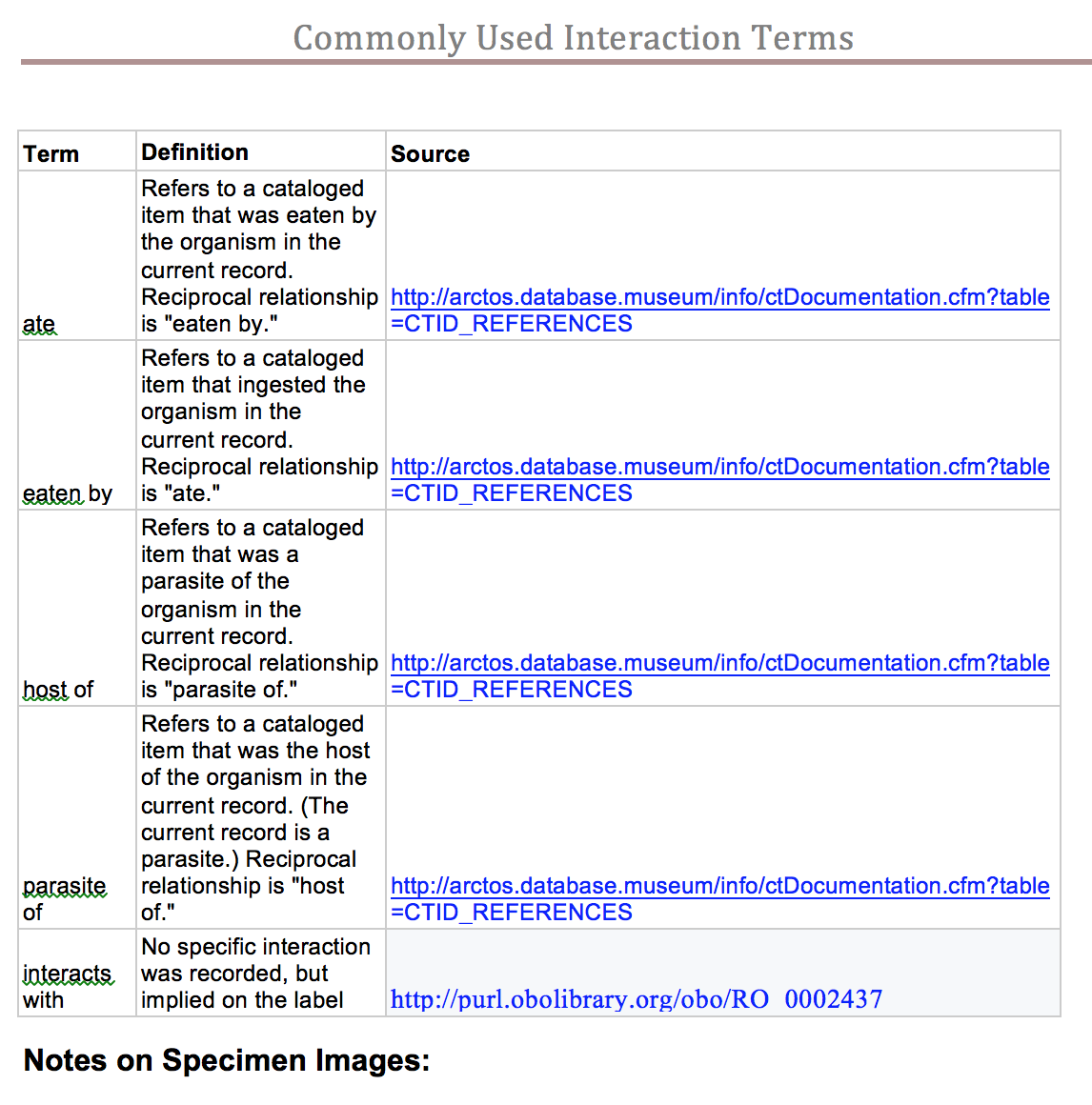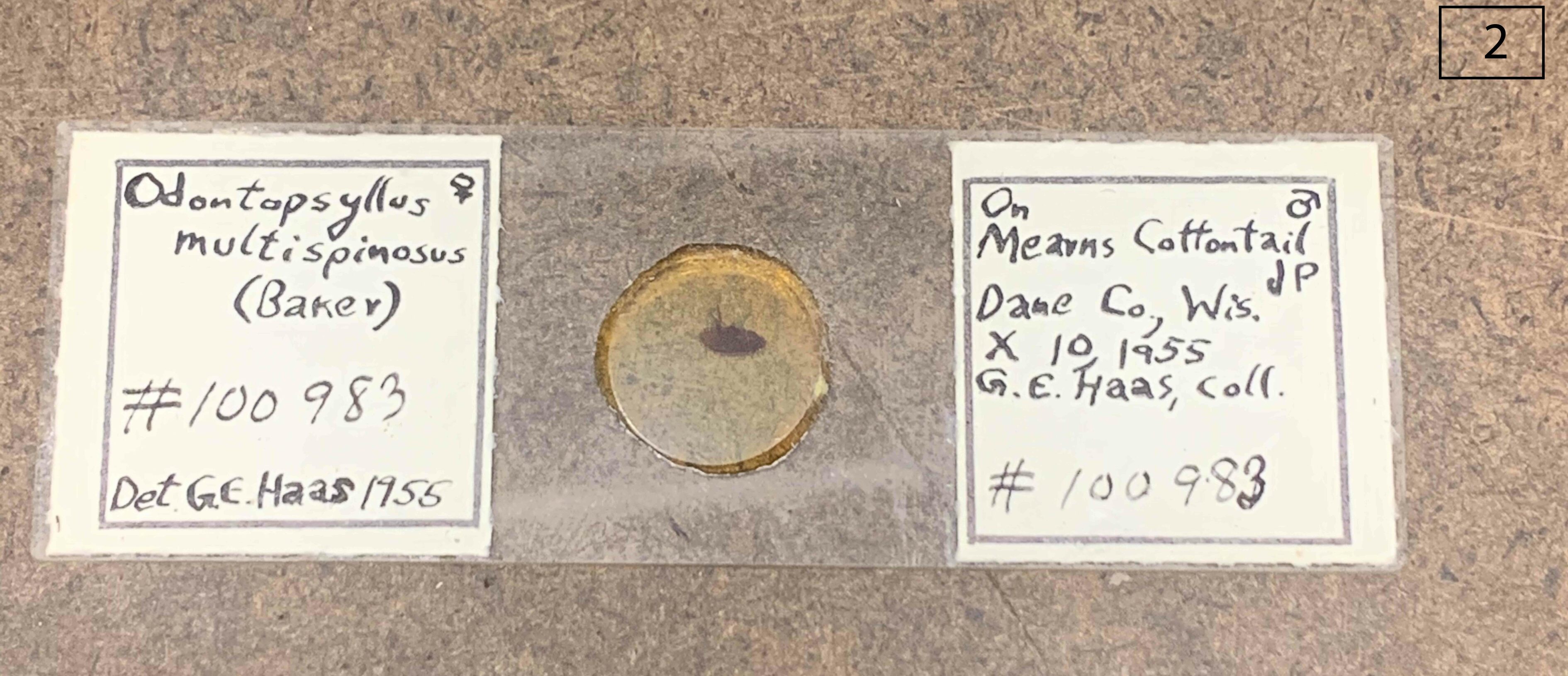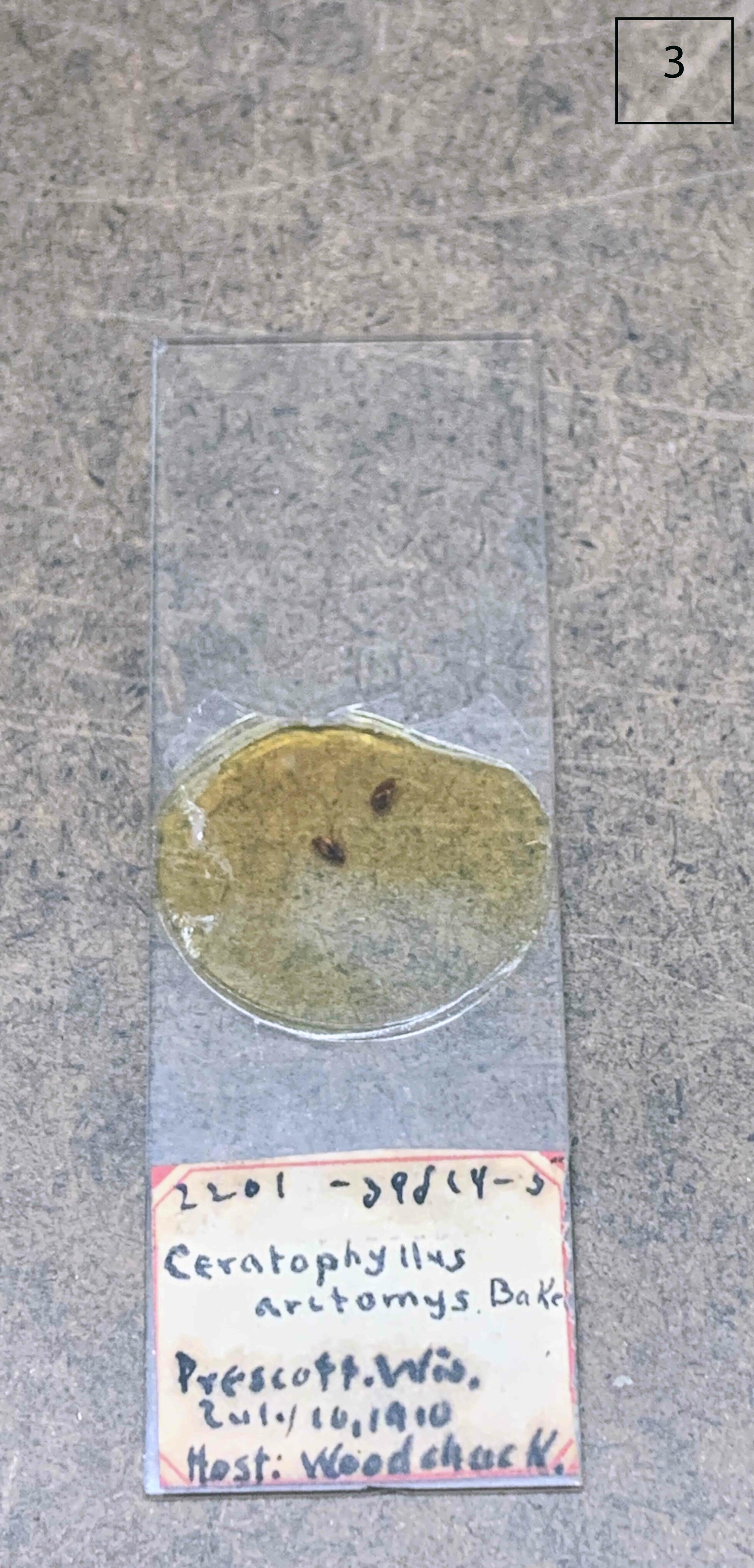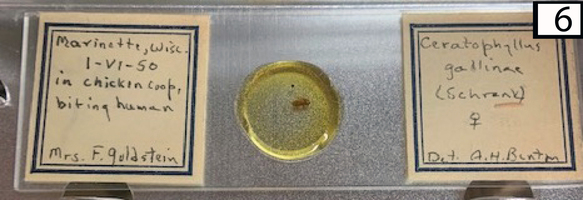Introduction & Examples
Overview
Teaching: 5 minutes min
Exercises: 0 minQuestions
What will we be doing?
What is the purpose of this exercise?
Objectives
Explain activity
Go over example specimens
Provide materials for workshop activity
Description
This hands-on exercise was developed to help data providers transcribe specimen-level data that contains information about associated taxa/specimens. This activity will be focused on parasite-host records, and how to consistently capture interaction data from specimen labels. We will examine specimens that vary in quality of available interaction information on the label and practice data transcription and interaction interpretation for downstream integration with GloBI.
Objectives
- Gain a better understanding of parasite collections interactions data
- Practice transcribing specimen interactions data using real examples
- Discuss (first in small groups, then as a network) different ways in which species interactions data can be interpreted
- Compile a list of verbatim terms currently used to describe associations on specimen labels
- Compile a set of ‘interaction types’ derived from ‘human interpreted interactions’
- Share outcomes (e.g., interactions translation table)
Where to find materials for this activity
- Individual transcription Worksheet (choose the best format for you):
- Group Transcription Worksheet (choose the best format for you):
- Commonly used Interaction Terms
- Transcription Images all on next episode page or individually:
- Example images:
Terms and Definitions
Commonly used Interaction Terms and Definitions:
 (available here: PDF version (.pdf))
(available here: PDF version (.pdf))
Worksheet columns and definitions:
- Verbatim Interaction Text (Interaction as on label without interpretation)
- Specimen Taxon name
- Human derived/interpreted interaction: Use examples from handout or come up with your own!
- Target Common Name, Target Taxon Name, Specimen Event Date, Target Sex, Target Body Part, Target Life Stage
- Additional Properties, or notes about interaction
- Do you have a new interaction? Please define it for us
Example 1.
 Worksheet with examples (multiple formats available, you only need one):
Worksheet with examples (multiple formats available, you only need one):
- xlsx file download
- csv download
- Google Sheets (download or make a copy)
Example 2.

 Worksheet with examples (multiple formats available, you only need one, same sheet as above):
Worksheet with examples (multiple formats available, you only need one, same sheet as above):
- xlsx file download
- csv download
- Google Sheets (download or make a copy)
Next Up: Individual Specimen Data Transcriptions
Key Points
Association data is not always straight forward
There may be different interpretations of data depending on the provider or user
Individual Data Transcriptions Worksheet Activity
Overview
Teaching: min
Exercises: 10 minQuestions
How do I transcribe this?
How do I intrepret the verbatim data?
Objectives
Transcribe the label data
Think about what common association term you would use
Think about how the interaction could be interpreted differently and if there may be a better term
Objectives
The goal of this exersise is to transcribe the association data from the label images provided and consider not just how you would interpret and classify an interaction, but how someone else may interpret the interaction.
Getting started
Download a copy of the activity spreadsheet to fill in, or open and make a copy you can edit in Google Drive or Google Sheets.
Transcribe the association data from each of the 7 specimen labels provided below into your spreadsheet. You can also open the images up in separate windows or tabs if you prefer with these links:
Specimen Images
There are 7 different specimen label images with association data to transcribe. Pick the worksheet format above best for you and transcribe the association data into the worksheet.
Specimen 1: Transcribe assocation data from label imageFill in all columns of the worksheet as appropriate.
Photo courtesy of: The Field Museum of Natural History Insect Collection
Specimen 2: Transcribe assocation data from label imageFill in all columns of the worksheet as appropriate.
Specimen 3: Transcribe assocation data from label imageFill in all columns of the worksheet as appropriate.
Specimen 4: Transcribe assocation data from label imageFill in all columns of the worksheet as appropriate.
Specimen 5: Transcribe assocation data from label imageFill in all columns of the worksheet as appropriate.
Photo courtesy of: Milwaukee Public Museum Invertebrate Zoology Collection
Specimen 6: Transcribe assocation data from label imageFill in all columns of the worksheet as appropriate.
Specimen 7: Transcribe assocation data from label imageFill in all columns of the worksheet as appropriate.
Photo courtesy of: The Field Museum of Natural History Insect Collection
Word Cloud! (SESSION 1)
One fun way to visualize results and find common terms is by creating a word cloud.
Share your interaction terms!➡️ Go to: https://www.menti.com/als8cx2muj1n
- Alternatively, go to www.menti.com and enter the code 3506 6926
➡️ Enter the different interaction terms you used for each specimen.
See the word cloud results in real time as everyone submits terms!
Live results can also be viewed here (https://bit.ly/ECMcloud1).
Word Cloud! (SESSION 2)
One fun way to visualize results and find common terms is by creating a word cloud.
Share your interaction terms!➡️ Go to: https://www.menti.com/al6w6bo3q3hd
- Alternatively, go to www.menti.com and enter the code 7153 9451
➡️ Enter the different interaction terms you used for each specimen.
See the word cloud results in real time as everyone submits terms!
Live results can also be viewed here (https://bit.ly/ECMcloud2).
Next Up: Small Group Data Transcriptions
Key Points
Association data on specimen labels can be highly variable
Matching data to availble terms can be confusing or interpreted differently
Small Group Data Transcriptions Worksheet Activity
Overview
Teaching: 0 min
Exercises: 15 minQuestions
Does everyone agree on the association terms for each specimen?
Why or why not?
Are there additional terms or fields that should be available?
Objectives
Discuss with your group what association terms were derived for each specimen
Make sure everyone has a chance to be heard
Come to a consensus association term that should be used for each specimen
Appoint group spokesperson for sharing your group’s results with the larger workshop group
Objectives
The goal of this exercise is to take the transcriptions and association data interpretations from your individual worksheets and discuss the results with your group to see how interpretations of interaction data can vary between transcribers. Group should discuss and try to come to an agreement for each specimen, record agreed upon terms (or new terms/categories needed) on group worksheet, and appoint spokesperson to share group results with whole class (next last portion of this workshop).
Exercise 1. Group worksheet & discussion
- Download a copy of the group activity spreadsheet to fill in, or open and make a copy you can edit in Google Drive or Google Sheets. Appoint one person to record/take notes for the group.
- Go over what everyone filled out in each association field and discuss any differences in interpretations or new terms invented.
- Do this for each specimen
- Make sure everyone has a chance to share, voice their opion, and ask questions
- Try to come to a consensus on what association terms should be used and what new terms or fields would be useful additions.
- The group recorder should write down agreed upon terms on worksheet or make note that the group could not come to an agreement
- Appoint someone to be the group spokesperson for the larger group discussion (next portion of this workshop).
- This can be a different person from the person recording/note taking
- The answers your group comes up with (or unresolved disagreements) will be discussed with the larger group for the last 30 mintues of the workshop
Word Cloud! (SESSION 1)
One fun way to visualize results and find common terms is by creating a word cloud.
Share your GROUP's interaction terms with a word cloud! (SESSION 1)➡️ Go to: https://www.menti.com/aladkj7nhs8o
- Alternatively, go to www.menti.com and enter the code 5135 7745
➡️ Enter the different interaction terms you used for each specimen.
See the word cloud results in real time as everyone submits terms!
Live results can also be viewed here (https://bit.ly/ECMcloud3).
Word Cloud! (SESSION 2)
One fun way to visualize results and find common terms is by creating a word cloud.
Share your GROUP's interaction terms with a word cloud! (SESSION 2)➡️ Go to: https://www.menti.com/algx7hq2wn5c
- Alternatively, go to www.menti.com and enter the code 7421 7946
➡️ Enter the different interaction terms you used for each specimen.
See the word cloud results in real time as everyone submits terms!
Live results can also be viewed here (https://bit.ly/ECMcloud4).
Next Up: Report & Whole Group Discussion
Key Points
There may be different interpretations about association data
It can sometimes be difficult to agree
Sometimes new terms or fields need to be created to adequately address the data available
Reports & Whole Group Discussion
Overview
Teaching: 0 min
Exercises: 30 minQuestions
Did everyone agree on association terminology?
Do we need additional association terms or fields?
Other thoughts?
Objectives
Report your small group’s finding to the whole group
Discuss different association terms and interpretations
Objectives
Each small group will summarize their discussion and share key points and conclusions with the whole group. Once each group has had a chance to share, the whole group will discuss similar and dissimilar findings between the different groups.
Exercise 1: Report your group's findingsAppoint a spokesperson to share your group’s results.
What association terms did you group use or need to create for specimen 1?
- Did all of your group agree? Why or why not?
- Did you need to create a new association term or field?
What association terms did you group use or need to create for specimen 2?
- Did all of your group agree? Why or why not?
- Did you need to create a new association term or field?
What association terms did you group use or need to create for specimen 3?
- Did all of your group agree? Why or why not?
- Did you need to create a new association term or field?
What association terms did you group use or need to create for specimen 4?
- Did all of your group agree? Why or why not?
- Did you need to create a new association term or field?
What association terms did you group use or need to create for specimen 5?
- Did all of your group agree? Why or why not?
- Did you need to create a new association term or field?
What association terms did you group use or need to create for specimen 6?
- Did all of your group agree? Why or why not?
- Did you need to create a new association term or field?
What association terms did you group use or need to create for specimen 7?
- Did all of your group agree? Why or why not?
- Did you need to create a new association term or field?
Exercise 2: Whole group discussionQuestion to think about:
- Do we need additional terms or fields in standard data collection methods/depositories?
- How does being a data provider vs data user change how we interpret the terms used with association data?
Word Cloud! (SESSION 1)
One fun way to visualize results and find common terms is by creating a word cloud.
Share the interaction terms you would use after dissussing them! (SESSION 1)➡️ Go to: https://www.menti.com/al3nv7xuwxra
- Alternatively, go to www.menti.com and enter the code 7785 8769
➡️ Enter the different interaction terms you used for each specimen.
See the word cloud results in real time as everyone submits terms!
Live results can also be viewed here (http://bit.ly/ECMcloud5).
Word Cloud! (SESSION 2)
One fun way to visualize results and find common terms is by creating a word cloud.
Share the interaction terms you would use after dissussing them! (SESSION 2)➡️ Go to: https://www.menti.com/alsnp3e82dk5
- Alternatively, go to www.menti.com and enter the code 166 697 9
➡️ Enter the different interaction terms you used for each specimen.
See the word cloud results in real time as everyone submits terms!
Live results can also be viewed here (https://bit.ly/ECMcloud6).
Additional information for referenceA full list of different association terms, definitions, and translation tables compiled so far are available below:
Resource Description OBO Relations Ontology project page OBO RO contains many kinds of terms, not just biotic associations terms List of OBO RO Biotic Interaction Terms with definitions a table of RO biotic interaction terms and their definitions (if available) List of GloBI Supported Interaction Terms subset of RO interactions terms that GloBI uses for indexing Default Verbatim Terms Translation Table the translation table used by GloBI to maps verbatim interaction terms to supported interaction terms Example of Custom Verbatim Terms Translation Table if provided/needed, GloBI can use a custom mapping provided by a collection
Next Up: Submit your worksheets
Key Points
Association data can be complicated
Association data may be interpreted differently
Data providers often think about data and terms differently that data users
Submit Your Worksheets
Overview
Teaching: 0 min
Exercises: 0 minQuestions
Will anything come of my answers?
Objectives
Submit your worksheets
Thank you! Please email me your worksheets!
Thank you for participating in this workshop! Hopefully this exercise sparked some interesting discussion.
After the workshop is complete, please email your worksheets to Erika. The results will be compiled and shared with you after the workshop. Novel results will also be made availble to those needing ideas on collecting and mapping assocation type data to database fields.
Your name will be kept annonymous in the final compiled results.
Email Erika or upload to Google DriveEmail your individual and group worksheet to Erika
- Alternatively, you can upload your worksheets to this shared Google Drive folder: Worksheet results 2023.
All individual responses will be kept annonymous in the final results compilation.
Thank you!
Key Points
Email copy of results to Erika
 Photo courtesy of:
Photo courtesy of:  Photo courtesy of:
Photo courtesy of:  Photo courtesy of:
Photo courtesy of:  Photo courtesy of:
Photo courtesy of: